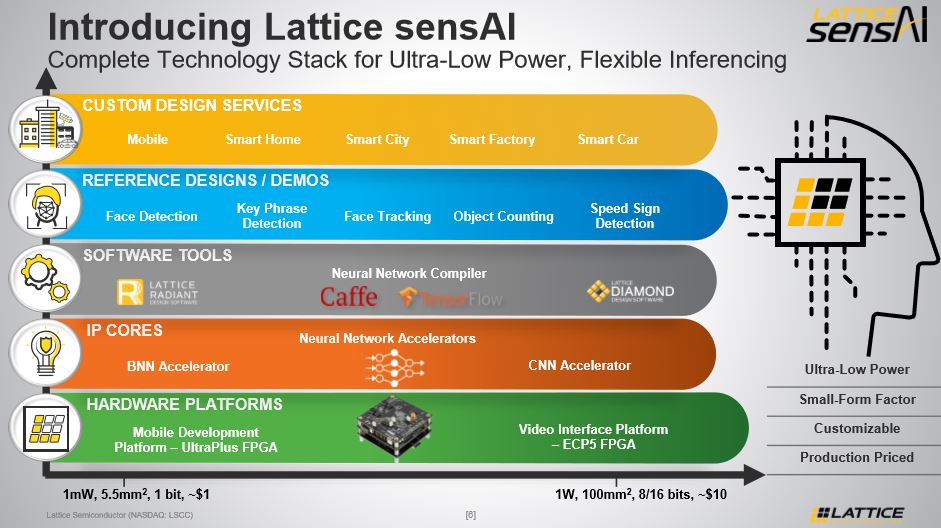Bringing AI in edge devices to the mass market
A complete technology stack combining modular hardware kits, neural network IP cores, software tools, reference designs and custom design services has been introduced by Lattice Semiconductor to accelerate integration of machine learning inferencing into broad market IoT applications.
With solutions optimized for ultra-low power consumption (under 1mW–1W), small package size (5.5-100mm2), interface flexibility (MIPI CSI-2, LVDS, GigE, etc.), and high volume pricing (~$1-$10), the Lattice sensAI stack fast-tracks implementation of edge computing close to the source of data.
Deepak Boppana, Senior Director, Product and Segment Marketing at Lattice Semiconductor, said: “There is an unmet need in the market for a silicon platform that’s both flexible and programmable and also has ultra-low power and is low cost and small size etc. That’s essentially what we’re trying to address with this launch.
“And Lattice has always been focussed on edge devices and are already shipping some of these types of devices in volume. And Lattice FPGAs are already being used for sensor bridging and data aggregation. So Lattice products are already sitting next to this data path – right next to IoT sensors, and we certainly think that’s a distinct advantage that we have, especially compared to a lot of startups that have solutions for the edge, but don’t have the same history that we do, or experience of shipping these types of devices. Lattice on the other hand already has existing customer relationships with edge device makers, and in terms of the architecture we are already sitting right next to the sensors.
“For us therefore, it’s a natural step to integrate the AI inferencing as that’s the next thing that happens in the data path after sensor bridging and data aggregation.
“By delivering a full-featured machine learning inferencing technology stack combining flexible, ultra-low power FPGA hardware and software solutions, the Lattice sensAI stack accelerates integration of on-device sensor data processing and analytics in edge devices. These new edge computing solutions build on our leadership in FPGAs for edge connectivity, implementing flexible sensor interface bridging and data aggregation in high volume IoT applications, including smart speakers, surveillance cameras, industrial robots and drones.”
“The Edge is getting smarter with more computing capabilities being deployed for real-time processing of data from an expanding range of sensors, as seen in the consumer IoT space, and the emergence of artificial intelligence is only accelerating this trend,” added Michael Palma, Research Director at IDC. “Low power, small size, and low cost silicon solutions that can perform such local sensor data processing, will be critical for implementation of AI in various broad market edge applications.”
Emerging edge computing
As the industry continues to adopt machine learning technology, latency, privacy and network bandwidth limitations are increasingly pushing computing to the Edge. IHS Markit expects 40B IoT devices at the Edge between 2018 and 2025, and predicts that in the next 5-10 years, the convergence of transformative technologies like IoT, AI-based edge computing and cloud analytics are expected together to disrupt each and every industry vertical and domain, as well as to foster new business opportunities.
AI in the Cloud has been happening for the past few years. Everything from our Gmail to the search engines we use are based on AI and machine learning. But AI in edge devices is a new trend.
It’s being driven by things like latency - where some of these systems need almost instant decision making (and you can’t afford to go back to the cloud for an answer); there are increasing privacy concerns – any time you send data to the Cloud you’re exposing it to potential hacks; and purely from a bandwidth limitation standpoint, the amount of video data that’s being generated is growing exponentially and even with things like 5G on the horizon it’s only going to hog the network if all this video data is sent over the Cloud. So there is a real desire to do some local processing in this regard.
So the trend for integration of AI at the edge is certainly there and Semico Research estimate that unit growth for edge devices with AI will explode – increasing over 110% CAGR over the next five years.
To address the computing opportunities at the Edge, Lattice’s sensAI stack includes the following:
- Modular Hardware Platforms – ECP5 device-based Video Interface Platform (VIP), including the award-winning Embedded Vision Development Kit, and iCE40 UltraPlus device-based Mobile Development Platform (MDP).
- IP Cores – Convolutional Neural Network (CNN) accelerator and Binarized Neural Network (BNN) accelerator.
- Software Tools – Neural network compiler tool for Caffe/TensorFlow to FPGA, Lattice Radiant design software, Lattice Diamond design software.
- Reference Designs – Face detection, key phrase detection, object counting, face tracking, and speed sign detection.
- Design Services – Eco-system of design service partners delivers custom solutions for broad market applications, including smart home, smart city, and smart factory.












